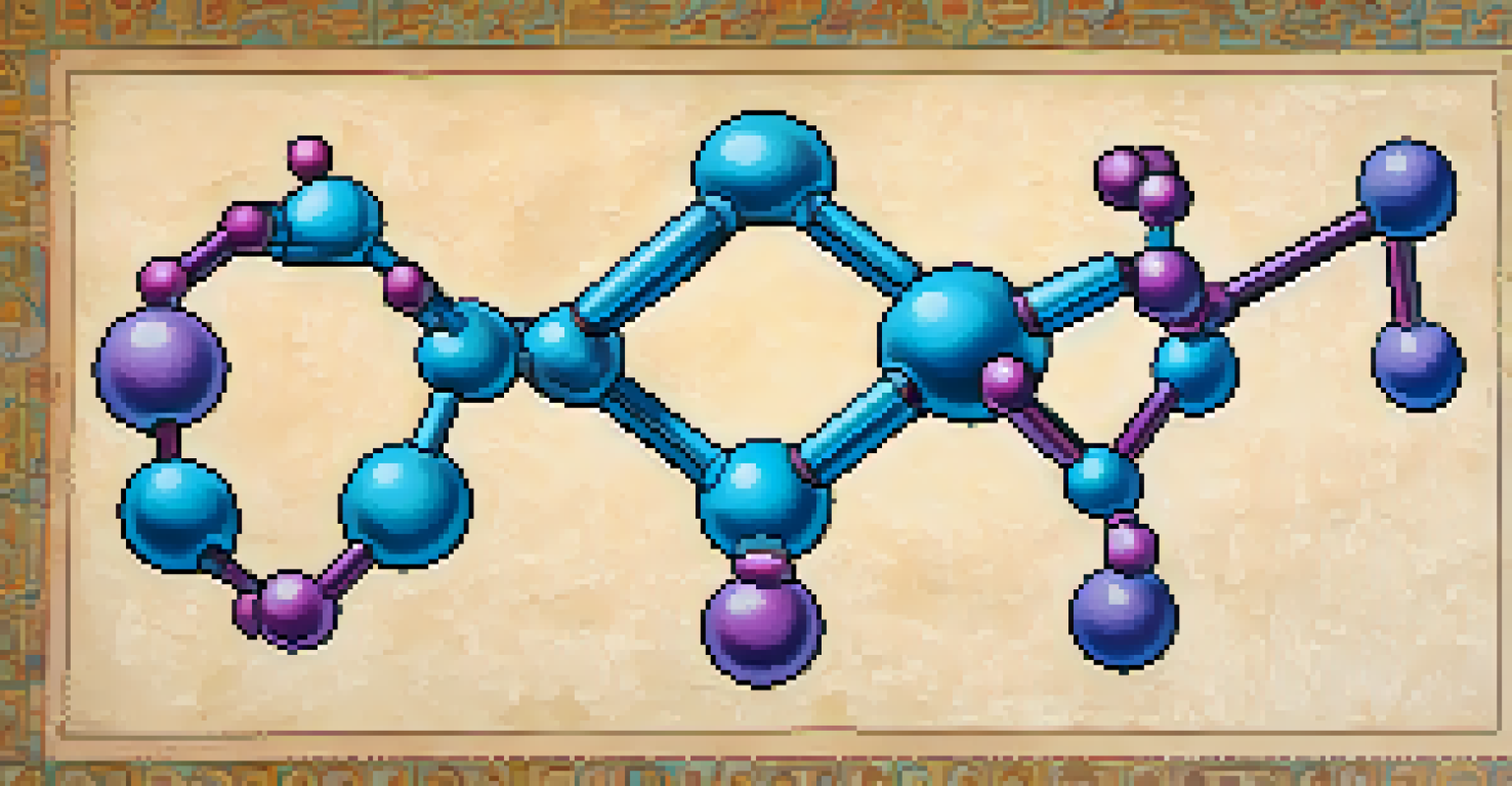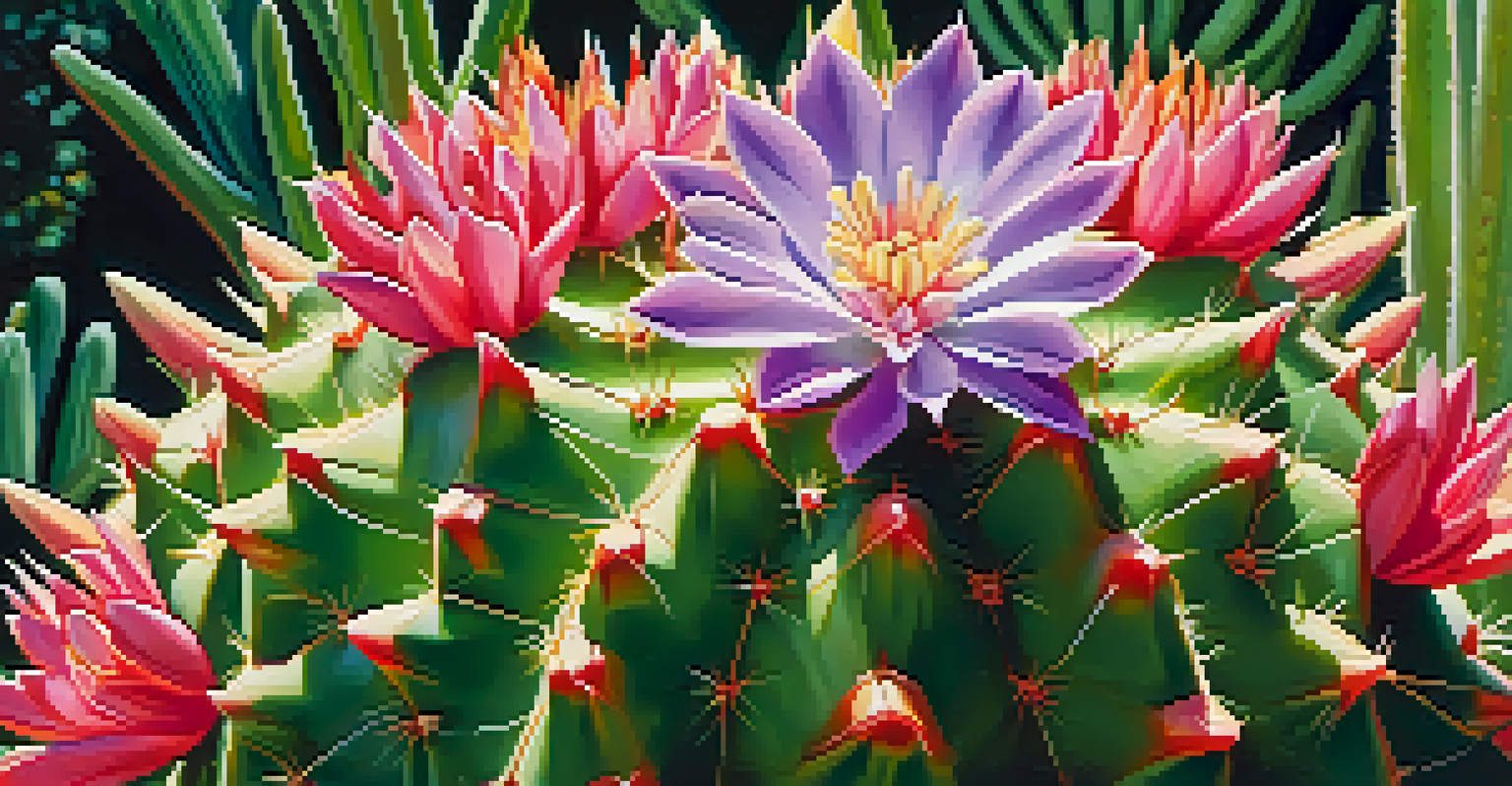Comparative Analysis of Mescaline and Other Psychedelics

Introduction to Mescaline and Psychedelics
Mescaline, a naturally occurring psychedelic found in certain cacti, has been used for centuries in various cultural rituals. When we talk about psychedelics, we are referring to a broad category of substances that alter perception, mood, and cognitive processes. The exploration of mescaline offers a unique perspective when compared to other well-known psychedelics like LSD and psilocybin mushrooms.
Psychedelics can offer a unique perspective on consciousness and perception, revealing the interconnectedness of all life.
Understanding mescaline's role in the psychedelic spectrum helps us appreciate its distinct properties. Unlike synthetic psychedelics such as LSD, mescaline is derived from nature, which appeals to many who seek a more organic experience. This natural origin often leads to a different set of expectations and experiences than those one might have with lab-created substances.
As we delve into the comparative analysis, it becomes essential to look at how mescaline interacts with the brain differently than other psychedelics. Each substance has its own unique effects, but they can also share common ground, leading to fascinating discussions about consciousness and perception.
Chemical Structure and Mechanisms of Action
Mescaline's chemical structure is similar to that of neurotransmitters like serotonin, which plays a crucial role in mood and perception. This similarity allows mescaline to bind to serotonin receptors, particularly the 5-HT2A receptor, leading to its psychedelic effects. In contrast, substances like LSD and psilocybin also target the same receptor, but their chemical makeups differ significantly.

The way these substances interact with the brain can dictate the nature of the psychedelic experience. For example, while mescaline tends to produce a more visual and sensory experience, LSD may lead to more profound cognitive shifts. By dissecting these differences, we can better understand how each psychedelic influences our mental and emotional states.
Mescaline's Unique Psychedelic Effects
Mescaline offers a distinct experience compared to other psychedelics, emphasizing sensory connections and introspection.
It's fascinating to observe how a small change in chemical structure can lead to vastly different experiences. This highlights the complexity of psychedelics and their potential therapeutic applications, as researchers look into how these substances can be harnessed for mental health benefits.
The Psychological Effects of Mescaline
Users often describe mescaline experiences as deeply introspective and connected to nature. This contrasts with the more stimulating and sometimes chaotic effects of other psychedelics like LSD, which can lead to visual distortions and intense thought processes. This unique quality of mescaline can foster a sense of unity with the environment, making it popular in spiritual and therapeutic settings.
The experience of mescaline is one of profound unity with nature, often leading to deep introspection and emotional breakthroughs.
Additionally, mescaline's effects can last longer than those of many other psychedelics, sometimes extending up to 12 hours. This prolonged experience can allow for deeper exploration of the self, but it also requires careful consideration regarding set and setting. Ensuring a supportive environment is crucial for a positive experience, especially given the potential for challenging emotional moments.
The psychological effects of mescaline can also vary greatly from person to person, influenced by their mindset and surroundings. This variability can lead to enriching experiences or, conversely, to feelings of anxiety if not properly managed.
Comparing Mescaline with Psilocybin
Psilocybin, the active compound in magic mushrooms, shares several similarities with mescaline, but also notable differences. Both substances can induce profound changes in perception and consciousness, yet their experiences can feel distinct. While mescaline often emphasizes visual and sensory connections, psilocybin may promote more emotional and introspective journeys.
The onset time is another area where these two psychedelics diverge. Mescaline typically takes longer to kick in, sometimes requiring up to two hours, while psilocybin can begin affecting users within 30 minutes. This difference can influence how individuals prepare for their experiences, with mescaline users often needing to be patient as they await the onset.
Therapeutic Potential of Mescaline
Research suggests mescaline may alleviate anxiety and depression, highlighting its potential in mental health treatment.
Moreover, the cultural contexts surrounding these substances are also quite different. Mescaline has been integral to Native American rituals for centuries, whereas psilocybin has seen a resurgence in interest due to modern therapeutic research. Understanding these cultural backgrounds enriches our appreciation of each substance's significance.
LSD vs. Mescaline: A Detailed Comparison
When comparing mescaline to LSD, both substances share similarities in their psychedelic effects but differ significantly in their intensity and duration. LSD is known for its potency, often requiring smaller doses to achieve profound effects. In contrast, mescaline generally requires a larger quantity, which can result in a more gradual onset and a different pacing throughout the experience.
LSD users often report a more cerebral experience, characterized by rapid thought patterns and visual hallucinations. Mescaline, on the other hand, tends to evoke a more grounded and sensory experience, focusing on emotional connections and a sense of tranquility. This distinction can influence how individuals choose to use these substances, whether for exploration or therapeutic purposes.
Ultimately, the choice between mescaline and LSD may come down to personal preference and the desired journey. Some may prefer the clarity of thought that LSD provides, while others might seek the earthy, introspective nature of mescaline.
Therapeutic Uses of Mescaline and Other Psychedelics
Recent studies have highlighted the potential therapeutic applications of psychedelics, including mescaline. Research suggests that mescaline may help alleviate anxiety and depression, similar to findings with psilocybin and MDMA. These substances can facilitate profound emotional breakthroughs, offering new perspectives to those struggling with mental health issues.
The therapeutic setting is crucial when using any psychedelic, as the environment can significantly impact the experience. Guided sessions, where trained professionals support individuals through their journeys, have shown promise in enhancing the therapeutic benefits of mescaline and other psychedelics. This safe space allows for exploration of emotions that may be difficult to access otherwise.
Safety Considerations for Users
Understanding set and setting, along with dosage awareness, is crucial for ensuring a safe experience with mescaline.
While the research is still developing, the shared potential of mescaline and other psychedelics in mental health treatment is an exciting avenue for exploration. As attitudes toward psychedelics shift, we may see more integration of these substances into mainstream therapeutic practices.
Safety and Risks Associated with Mescaline and Psychedelics
Like any substance, mescaline and other psychedelics come with their own set of risks and safety concerns. While they are generally considered low-risk in terms of physical harm, the psychological impact can be significant. Individuals with a history of mental health issues should approach these substances with caution, as they can exacerbate underlying conditions.
Set and setting play a vital role in ensuring a safe experience. A supportive and comfortable environment can help mitigate anxiety or paranoia that may arise during a trip. It's also essential to consider the influence of dosage, as higher amounts can lead to overwhelming experiences that may be difficult to process.

Being informed and prepared can greatly enhance the safety of using mescaline and other psychedelics. Understanding personal limits, educating oneself about the substance, and having a trusted trip-sitter can help users navigate their journeys more safely.